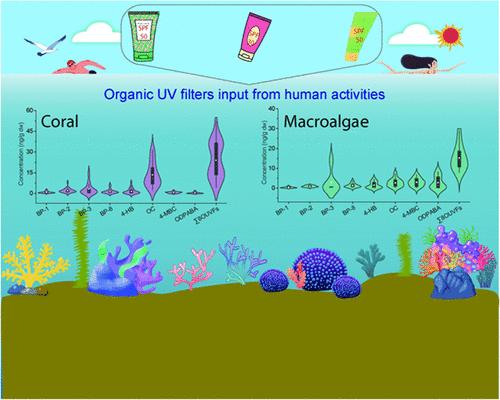探索有机紫外线过滤器对三亚鹿回头珊瑚礁生态系统中珊瑚和大型藻类的潜在威胁
IF 11.3
1区 环境科学与生态学
Q1 ENGINEERING, ENVIRONMENTAL
引用次数: 0
摘要
有机紫外线过滤剂(OUVFs)在珊瑚礁生态系统中的广泛存在引起了越来越多的关注。本研究分析了中国三亚鹿回头环礁生态系统中珊瑚、大型藻类和沉积物中有机紫外线过滤剂的浓度和组成。检测到的 OUVFs 包括二苯甲酮-1、-2、-3 和-8(BP-1、BP-2、BP-3 和 BP-8)、4-羟基苯甲酸(4-HB)、辛二烯(OC)、4-甲基亚苄基樟脑(4-MBC)和辛基二甲基对氨基苯甲酸(ODPABA)。珊瑚组织和大型藻类中的总浓度(∑8OUVFs)分别为 4.3-52.0 纳克/克干重(dw)和 8.0-29.0 纳克/克干重(dw)。珊瑚组织中 BPs(包括 BP-1、BP-3 和 BP-8)和 OC 的生物累积因子(BAFs)高于大型藻类,而 4-MBC 和 ODPABA 的生物累积因子(BAFs)则相对较低。初步风险评估结果表明,在最坏的情况下,超过 65% 和 84% 的珊瑚样本中的 BP-3 浓度分别超过了导致珊瑚幼虫白化和死亡的阈值。同时,99% 的大型藻类样本显示 ODPABA 浓度超过了抑制其生长的阈值。因此,BP-3 和 ODPABA 对珊瑚和大型藻类构成重大生态风险,进而威胁珊瑚礁生态系统的健康和稳定。本文章由计算机程序翻译,如有差异,请以英文原文为准。

Exploring the Hidden Threat of Organic UV Filters to Corals and Macroalgae in Coral Reef Ecosystem from Luhuitou, Sanya, China
The widespread presence of organic UV filters (OUVFs) in coral reef ecosystems has attracted increasing attention. This study analyzed the concentrations and compositions of OUVFs in corals, macroalgae, and sediments in the Luhuitou fringing reef ecosystem in Sanya, China. The detected OUVFs included benzophenones-1, -2, -3, and -8 (BP-1, BP-2, BP-3, and BP-8), 4-hydroxybenzoic acid (4-HB), octocrylene (OC), 4-methylbenzylidene camphor (4-MBC), and octyl dimethyl-p-aminobenzoic acid (ODPABA). The total concentrations (∑8OUVFs) in coral tissues and macroalgae were found to be 4.3–52.0 and 8.0–29.0 ng/g dry weight (dw), respectively. The bioaccumulation factors (BAFs) for BPs (including BP-1, BP-3, and BP-8) and OC in coral tissues were higher than those in macroalgae, while the BAFs for 4-MBC and ODPABA were relatively lower. Preliminary risk assessment results indicated that, in the worst-case scenario, more than 65 and 84% of coral samples had BP-3 concentrations exceeding the thresholds for causing coral larval bleaching and mortality, respectively. At the same time, 99% of the macroalgae samples showed ODPABA concentrations exceeding the thresholds related to their growth inhibition. Therefore, BP-3 and ODPABA posed significant ecological risks to corals and macroalgae, subsequently threatening the health and stability of the coral reef ecosystem.
求助全文
通过发布文献求助,成功后即可免费获取论文全文。
去求助
来源期刊

环境科学与技术
环境科学-工程:环境
CiteScore
17.50
自引率
9.60%
发文量
12359
审稿时长
2.8 months
期刊介绍:
Environmental Science & Technology (ES&T) is a co-sponsored academic and technical magazine by the Hubei Provincial Environmental Protection Bureau and the Hubei Provincial Academy of Environmental Sciences.
Environmental Science & Technology (ES&T) holds the status of Chinese core journals, scientific papers source journals of China, Chinese Science Citation Database source journals, and Chinese Academic Journal Comprehensive Evaluation Database source journals. This publication focuses on the academic field of environmental protection, featuring articles related to environmental protection and technical advancements.
 求助内容:
求助内容: 应助结果提醒方式:
应助结果提醒方式:


